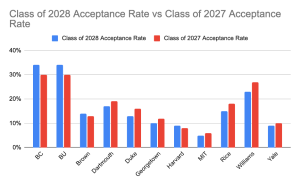
The Common Application recently released a report on trends in early college applications, and several member colleges have released their own admissions data for the Early Action and Early Decision pools. We have compiled some of the most notable facts and figures to help you understand the current admissions landscape, including trends in application numbers, diversity, standardized testing, and acceptance rates.
Application Numbers
According to the Common App, 836,679 distinct first-year candidates submitted applications to enroll in the 2024–25 academic year. These students applied to 834 Common App member schools. This is a 41% increase from the application numbers in 2019-20, which was the last year the pandemic did not affect admissions numbers. The total applications received by colleges themselves in 2023–24 (3,353,516) increased by 65% from 2019–20 (2,028,507). Applicants were also applying to slightly more members in 2023–24 than in 2019–20 (up 17%, from 3.42 to 4.01 applications per applicant).
Diversity
Underrepresented minority (URM) applicants increased by 67% compared to 2019-20. Last year, there had only been a 37% increase since 2019-2020. The Common App defines “underrepresented minorities” as “students of Hispanic/Latino, African-American, Pacific Islander, and Native American origin or background.”
The number of international applicants increased by 87% over 2019-20, compared to a 38% increase in domestic applicants. The countries with the most applicants were Bangladesh, Nepal, Ethiopia, and Nigeria.
First-generation applicants increased by 67%, about twice the rate of continuing-generation applicants over the same period.
In terms of economic diversity, students reporting eligibility for a Common App fee waiver increased at about four times the rate of students not reporting fee waiver eligibility (100% vs. 28%). Moreover, growth in applicants from lower-income ZIP codes continued to outpace their peers–these applicants accounted for52% this cycle versus 34% in 2019–20.
Standardized Testing
The proportion of Common App members requiring standardized test scores
since 2019–20 has changed significantly—from about 55% to just 5% in 2021–22. This season, just 4% of members require a test score to submit an application.
After some years of fluctuation, the percentage of college applicants who submit standardized test scores has settled at about half. Recent application cycles saw a steep decline in applicants reporting standardized test scores (from 75% in 2019-2020 to only 45% in 2020-2021) as more schools adopted test-optional policies during the pandemic. This year’s cycle saw 49.6% of students opt to submit their applications without test scores.
Acceptance Rates
Admission to highly selective colleges and universities has only gotten more competitive in the last few years, and this year is no different. While a few colleges have reported higher admit rates this year than last, the overall trend is still toward lower admit rates.
Note that several schools have opted not to report their early action and early decision acceptance rates, including Barnard, Columbia, Cornell, Northwestern, Stanford, University of Pennsylvania, and Princeton.

You’ve now familiarized yourself with the data and trends of this year’s early application cycle. If you’re applying to college in future cycles, make sure that the schools on your list are still a suitable fit for you. As you take the final steps in revising your essays and updating your activities list, use the data to your advantage and make the decision that’s best for you.
Leave a Reply